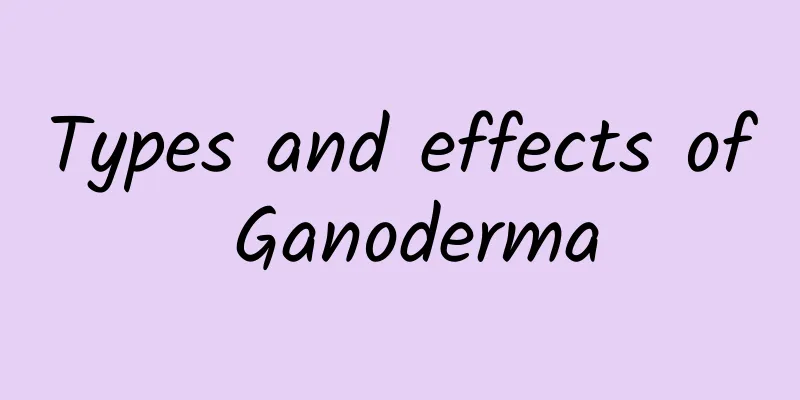Types and effects of Ganoderma

|
I believe everyone is familiar with Ganoderma lucidum. It is a medicinal material with extremely high nutritional value. It mainly grows in areas with extremely harsh climate and environment such as Changbai Mountain. Therefore, Ganoderma lucidum is shrouded in a veil of mystery and is very precious and rare. Many people want to know what types of Ganoderma lucidum there are and what effects they have. In fact, different types of Ganoderma lucidum have different effects. 1. Red Ganoderma, also known as Dan Ganoderma, is bitter, flat and non-toxic. Morphological characteristics: corky, with handle. The cap is kidney-shaped, semicircular or nearly circular, with a reddish-brown surface and a lacquer-like luster, and the stipe is the same color as the cap or darker. It has anti-tumor and tumor prevention effects, is beneficial to heart function, can enhance immunity, regulate high and low blood pressure, and long-term consumption can make the body light, prevent aging, and prolong life. Scientific research is all carried out using red Ganoderma lucidum as a representative. 2. Purple Ganoderma Ganoderma lucidum, also known as Wood Ganoderma, is sweet, warm and non-toxic. Morphological characteristics: The cap is brown, purple-black to nearly black, and the flesh is evenly brown to chestnut brown. It is mainly used to treat deafness, strengthen the kidneys, strengthen the muscles and bones to improve complexion. Long-term consumption can make the body light, prevent aging and prolong life. 3. Black Ganoderma Black Ganoderma, also known as Xuan Ganoderma, is mild and non-toxic Morphological characteristics: Wrinkled-capped black mushroom: The cap is kidney-shaped or quasi-circular, with a diameter of 3-10 cm and a thickness of 5-7 mm. The surface is gray-brown or brown, with fine hairs, deep radial wrinkles and inconspicuous rings, sharp and wavy edges, and multiple lobes. The tube mouth surface is white or dark brown. It is beneficial to the kidneys, promotes diuresis, opens the nine orifices, improves observation, and eliminates accumulation; it is mainly used to treat acute nephritis, chronic nephritis, and indigestion. 4. Green Ganoderma Green Ganoderma, also known as Dragon Ganoderma, is sour, flat and non-toxic. It mainly has the functions of improving eyesight, nourishing the liver and replenishing qi. Long-term consumption can make the body light, prevent aging and prolong life. "Baopuzi" says: "The green one is like emerald feathers." 5. White Ganoderma White Ganoderma, also known as Jade Ganoderma, is pungent, mild and non-toxic. Morphological characteristics: The fungus has white flesh and is shaped like a horseshoe. It grows on pine trees and other coniferous trees. It is mainly used to treat cough, shortness of breath, strengthen the lung qi, and clear the mouth and nose. Eating it regularly can make you light, prevent aging and prolong your life. 6. Yellow Ganoderma Huangzhi, also known as Jinzhi, is sweet, mild and non-toxic. It is mainly used to treat diseases of the heart and abdomen, that is, diseases of the chest and abdomen. It is beneficial to the spleen caused by the pancreas, can make the heart's spirit smooth. Long-term consumption can make the body light, prevent aging, and prolong life. Ganoderma lucidum has very rich pharmacological components, and dozens of them have been isolated so far, mainly including Ganoderma polysaccharides, Ganoderma acid (triterpenes), adenosine, amino acids, proteins, organic germanium and trace elements. Since the growth environment of artificially cultivated Ganoderma lucidum can be scientifically controlled, its active ingredients are more stable than those of wild Ganoderma lucidum and can be obtained in a short time. However, organic germanium and trace elements are often difficult to produce or even lacking, which is its own disadvantage. Why is it said that thousand-year-old Ganoderma lucidum can make people rejuvenate and bring back the dead? The key lies in the accumulation of its pharmacological components over time! Ganoderma lucidum has a great effect in strengthening the body, enhancing immune function and improving the body's resistance. It is different from general medicines that treat certain diseases, and also different from general nutritional health foods that only supplement and strengthen the deficiency of nutrients in a certain aspect. Instead, it regulates the balance of human functions in an overall two-way manner, mobilizes the body's internal vitality, regulates the body's metabolic function, improves the body's immune ability, and promotes the normalization of the functions of all internal organs. |
<<: The efficacy and function of Cordyceps tea
>>: What are the effects and functions of Sophora flavescens?
Recommend
Astragalus membranaceus efficacy and function pictures
Scutellaria baicalensis, also known as Astragalus...
What are the effects of Poria powder
Poria powder refers to the powder of the traditio...
The efficacy and function of croton shell
Croton shell is a medicinal material. If we have ...
In order to stop having nightmares, I tried to make up a "good ending" for it, and it actually worked!
Generally speaking, if you have a good night'...
The efficacy and function of snow chrysanthemum
Snow chrysanthemum is also known as iceberg snow ...
The efficacy and function of tiger tail wheel
We can often see tiger tail wheels in daily life,...
What are the dangers of eating too much Lingzhi?
Ganoderma lucidum has been regarded as the holy h...
What does it mean when cholesterol is too high? Is lower the better? How can we control it?
Many people find that their total cholesterol lev...
The efficacy and function of Tiger Tail Orchid
Tiger tail orchid is a traditional Chinese medici...
Don’t think of cervical spondylosis when you feel dizzy. It may be “otolithiasis”. If you meet the following 4 points, you can basically diagnose it.
Have you ever experienced this: waking up in the ...
Why did life evolve the function of death?
Survival or destruction? This is not only a philo...
If you are in a hurry, please take the stairs! It is not a good habit to walk on the left and stand on the right when taking the escalator →
Review expert: Wang Shengwei, Senior Engineer, Be...
The efficacy and function of acacia root
The world is full of wonders, and Chinese medicin...
2023 Nobel Prize in Chemistry: The periodic table now has a third dimension
The 2023 Nobel Prize in Chemistry was awarded for...
What are the effects and functions of honeysuckle tea
Honeysuckle is a very precious tea. After being d...









